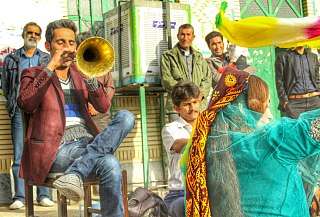Luri music
Luri music is referred to an ethno-cultural characteristic of Lurs in the Middle East. Luri music enjoys a various and ancient background,[1][2] and it can be divided into two parts: vocal and instrumental music.

Types of music
Based on the songs, Luri music is divided into seven sections;
- Music of lyrics and romantic songs: Including music regarding lyrics that is about the expression of both the pain of loss or separation and the beauty of love in spite of that pain. These musics like Heylaw, Binâ-binâ, Shirin & Khosrow lyrics, Sârixâni and Miruna (Mirbaygi) are performed in different Luri music mughams.
- Music of Epic-Combat songs: These hymns represent the epic and combat values of the warriors among the tribes. The most famous examples of this section are Jange Loru and Dâya-Dâya.
- Music and songs of mourning: This music has more to do with the rituals and has been used extensively in mourning ceremonies from the ancient times. Čamari (also Čamariuna), Sahari, Šivani and Pâkotali are from the most famous of these moghams.
- Music and songs of seasons: music and special songs of different seasons like Barza-kuhi, Kuč-bâru and Mâla-jiri
- Music and songs related to work activities: To ease and speed up the work of nomadic men and women, these songs (e.g Barziari, Hawla) are sung individually or collectively.
- Comic music and songs: These are usually originated from impromptu satires about people, places or objects and are sometimes accompanied by humorous dramatic movements of someone or people.
- Religious hymn-music: These are generally based on the words of Yaresan (from the hymns of Ahle-haq), and their mystical and religious aspects are very deep.
Music instruments
The most popular Luri musical instruments include Sorna, Dohol, Tâl (Luri kamancheh),[3] Tonbak (Tomak), and the common Iranian traditional instruments. Meanwhile, the Luri kamancheh is the only one that is fundamentally different from other ethnic music instruments.[4] The Lurs select the Mâhur as their basic musical step to showcase the magnificence, grandeur and independence of their people.[5]
After 1979 revolution of Iran
After 1979 revolution of Iran due to intense encounters with musical performances, especially ethnic music, the amount of music participation in different parts of the life of the Lurs was reduced however in the past, cheerful music and lyrics were accompanied with collective dance.
See also
References
- Majedi, H and S. Shamlukia, (2008): Investigating the impact of nature and the environmen on the Iranian music.(In Persian) Environmental sciences and technology: volume13, Number2, Pages 95-103
- Saeb, Reza. Archived 2017-08-03 at the Wayback Machine "Music status in Luristan"], Bamdadelorestan, KhorramAbad, 19 October 2015. Retrieved on 03 July 2017.
- Oloumo, M.(2015).Kamanche, the Bowed String Instrument of the Orient.International Journal of Arts and Commerce.Vol4, No 1, 92-101, available online at: Archived 2017-08-06 at the Wayback Machine
- تحقیق در مورد تال (کمانچه لرستان)، سید رسول صدریه.
- Majedi, H and S. Shamlukia, (2008): Investigating the impact of nature and the environment on the Iranian music.(In Persian) Environmental sciences and technology: volume13, Number2, Pages 95-103